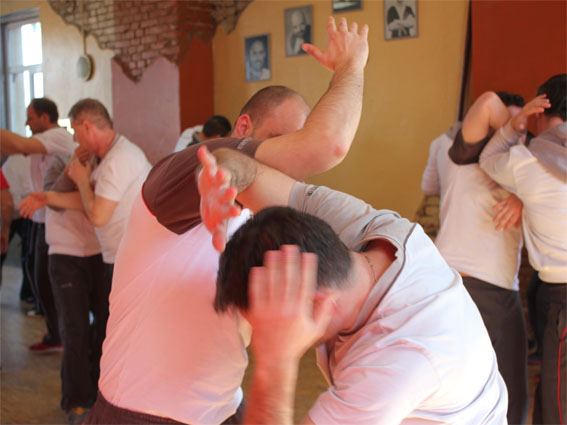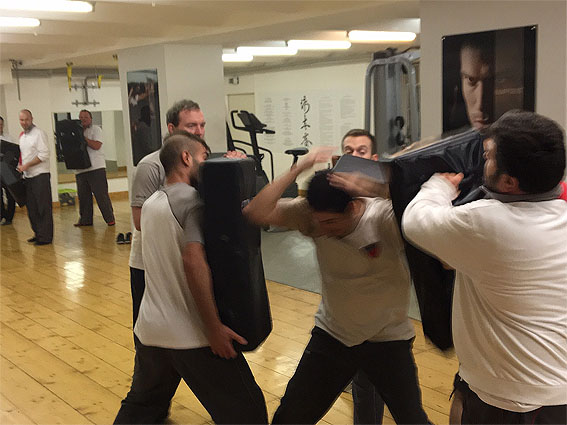Training against ambush
I have recently been repeatedly asked for my opinion about the incidents that took place in Cologne on New Year's Eve. The general view seems to be that "There's nothing you can do in these cases. Self-defence or in particular WingTsun can't help you there either."
I disagree completely with this, and in this editorial I will examine the subject in detail.
In the EWTO we have a tried-and-tested means of self-defence in male ritual combat in the form of BlitzDefence. In this case the approach usually comes in phases:
- Eye-contact
- Rhetorical phase
- Pointing with the finger/shoving
- Wild, curved attacks (haymakers)
- Kicking the downed opponent (degenerate phase)
Prof. Keith R. Kernspecht already described these phases years ago. But it is not only in male ritual combat, but also in the case of attacks against women, that the phases are in most case the same or similar. At least the first two phases also usually take place. In female-specific situations (attacks by men) it is important to train for escalation situations and prevent them, following the motto: "Draw boundaries, guard your boundaries, defend your boundaries." (See report by Sifu Sabine Mackrodt in "WingTsun World" No. 39 and the book "Defend Yourself3" by Prof Keith R. Kernspecht and André Karkalis).
In female-specific situations (attacks by men) it is important to train for escalation situations and prevent them, following the motto: "Draw boundaries, guard your boundaries, defend your boundaries." (See report by Sifu Sabine Mackrodt in "WingTsun World" No. 39 and the book "Defend Yourself3" by Prof Keith R. Kernspecht and André Karkalis).
But if someone decides to attack another person suddenly, either alone or as a group, we can no longer call this "ritual combat" or an "attack", but rather an "ambush".
It is difficult if not impossible to prepare for an ambush. Nonetheless the EWTO has specific programmes in which male and female students learn right from the start how to massively improve their chances in such situations.
This is not a matter of individual techniques, but of reactions. Every person inherently possesses so-called shock reactions. When somebody e.g. opens a high wardrobe and something starts to fall out from above, he/she will rapidly and instinctively raise his/her arms to stop it. So why should we not make use of such reactions in the case of an ambush?
Accordingly we do not learn and practice individual techniques, but rather train so that if we e.g. lose our balance after being pushed, we can regain it immediately while protecting ourselves at the same time, followed by lightning-fast attacks where it damages the opponent most (eyes, neck, genitals).
This response is first developed with special training methods from the EWTO programmes. For advanced students there are also dedicated ChiSao exercises which are practiced against multiple opponents.
So we do not practice techniques, but rather fast reactions and capabilities!
Most importantly:
- Keep moving all the time, maintaining your flow of movement. It is harder to hit a
moving target. - Constantly attack vital areas
- Stay loose – even under pressure! If you tense up, you stay still.
- Maintain your balance. This too requires practice!
- Timing: protect yourself while still dishing out effective attacks.
The rest is training methods, partly using large pads, obtaining the help of one or more partners and with a variety of situational exercises.
 Anyone now objecting that "Even the best WingTsun fighter has no chance against 50 attackers" would be quite right (unless his name is Donnie Yen and he is playing Yip Man in the film). However (!): I am certain that with correct and effective training, a woman (or man) mounting a vehement defence will injure several attackers so severely
Anyone now objecting that "Even the best WingTsun fighter has no chance against 50 attackers" would be quite right (unless his name is Donnie Yen and he is playing Yip Man in the film). However (!): I am certain that with correct and effective training, a woman (or man) mounting a vehement defence will injure several attackers so severely
- that the police will find them later, as they will need to seek medical attention.
- that the other opponents will usually stop attacking, as reports by women after the night in Cologne showed: "The attackers only stopped when I violently defended myself."
It is also a proven fact that victims who physically defended themselves are better able to cope psychologically with an attack. Victims who do not mount a physical defence often blame themselves, and suffer from this feeling of blame all their lives.
Your GM Oliver König




